97th Evacuation Hospital Unit History
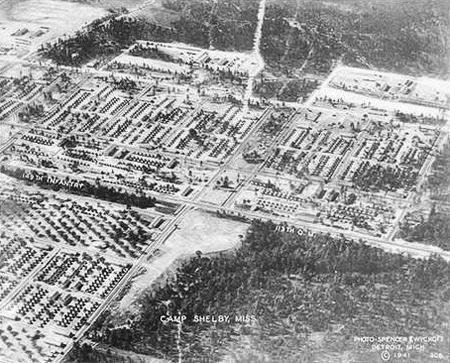
Aerial view of Camp Shelby, Hattiesburg, Mississippi. Picture taken in 1941.
Introduction & Activation:
The organization was originally activated 20 August 1942, at Cp. Shelby, Hattiesburg, Mississippi (Division Camp –ed), as the 9th Surgical Hospital. The cadre consisting of 1 Officer and 20 Enlisted Men was furnished by the 63d Surgical Hospital, stationed at Ft. Oglethorpe, Chattanooga, Tennessee (Women’s Army Corps Training Center –ed). It arrived at Camp Shelby on 23 August 1942. Captain Michael F. Powers assumed command of the unit the very same day. On 8 September 1942, the unit was officially re-designated the 97th Evacuation Hospital (Mtz).
It should be noted that in view of the need to provide Hospitals for overseas service, the Medical Department discovered and attempted to correct shortcomings and errors in its initial pre-war planning. It soon appeared that units originally planned for Theaters of Operations were not always suitable for all situations encountered in modern war and units of new types had to be developed. Size and weight of equipment had to be reduced and new methods of packing had to be developed in order to increase mobility and transportability of Hospitals in general. A number of (non-affiliated) Surgical Hospitals activated in 1940 and 1941 were affected and subsequently re-organized. Most of them were re-designated Evacuation Hospitals in lieu of Surgical Hospitals (with some of them being re-designated Station Hospitals –ed).
6th Surgical Hospital > 91st Evacuation Hospital (Mtz),31 August 1942 (served in North Africa)
7th Surgical Hospital > 92d Evacuation Hospital (Mtz), 25 August 1942 (served in Australia)
9th Surgical Hospital > 97th Evacuation Hospital (Mtz), 8 September 1942 (served in Europe)
11th Surgical Hospital > 99th Evacuation Hospital (Mtz), 25 August 1942 (served in the Pacific)
48th Surgical Hospital > 128th Evacuation Hospital (SM), 1 May 1943 (served in North Africa, Sicily, and Europe)
61st Surgical Hospital > 93d Evacuation Hospital (Mtz), 25 August 1942 (served in North Africa)
63d Surgical Hospital > 94th Evacuation Hospital (Mtz), 25 August 1942 (served in North Africa)
74th Surgical Hospital > 95th Evacuation Hospital (Mtz), 25 August 1942 (served in North Africa)
Organization:
The next CO of the 97th Evac was Captain Robert McElroy. He was however replaced on 22 September 1942 by Major Thomas T. Beeler, Jr. who now assumed command. The latter Officer joined the organization after leaving the 54th Evacuation Hospital (Mtz). By 15 November 1942, the Hospital had reached its full complement of Officers and EM (less Nurses) in accordance with T/0 8-581 (1942) which called for 39 Officers, 1 Warrant Officer, 48 Nurses, and 248 Enlisted Men.
The purpose of this organization was to erect and operate a 400-bed mobile Hospital under canvas, capable of providing early definitive treatment to battle casualties. As explained earlier, the unit was designed to perform the function of either an Evacuation Hospital or a Surgical Hospital and could replace either or both in the Army medical service. Personnel were assigned to the Administration section or to the Professional services.
Personnel & equipment were assigned and distributed to the following Hospital sections:
Headquarters Section
Administrative Service + Professional Service
Registrar and Detachment of Patients + Medical Service
Medical Detachment + Surgical Service
Receiving Section + Laboratory Service
Evacuation Section + X-Ray Service
Mess Section + Dental Service
Supply and Utilities Section + Nurses Section
Late December 1942 (or early January 1943), Colonel William S. George assumed command of the unit. The Hospital finally obtained its ANC complement. 20 members of the Army Nurse Corps joined from the Station Hospital at Cp. Grant, Rockford, Illinois (Medical Replacement Unit Training Center –ed) and 3 American Red Cross workers were temporarily assigned for participation in the Louisiana Maneuvers scheduled for 29 January to 9 April 1943. A permanent staff of 40 Nurses was acquired during the year; 20 in July and 20 more in October 1943.
Basic Training & Maneuvers:
Basic Training was temporarily interrupted in January 1943 when the unit was ordered to move to the planned area of the Louisiana Maneuvers. These field exercises lasted 11 weeks, after which the unit returned to Cp. Shelby to resume Basic Training which was eventually successfully completed.
This first phase was followed by unit training consisting of technical training of Hospital personnel, individual Hospital sections, and field bivouac of the Hospital as a unit. An 8-hour “forced hike” of 25 miles was completed by most personnel. The Unit training examination was successfully passed early in July 1943.
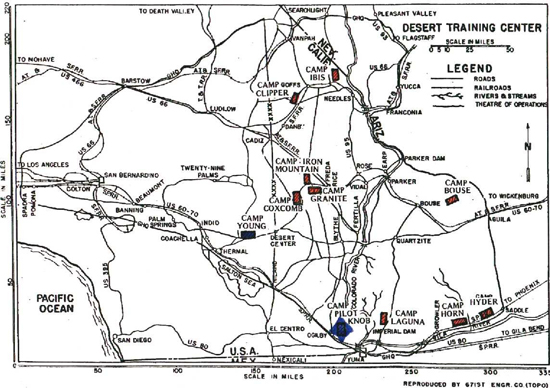
Map of the Desert Training Center. Following the German success in North Africa, George S. Patton, Jr., was sent by the War Department to California in March 1942, to establish a Headquarters for the Desert Training Center. The main Headquarters were set up at Camp Young. In 1943, the facilities were redesignated CAMA, California-Arizona Maneuver Area.
During March 1943 the descriptive designation was changed from “Mtz”, Motorized, to “SM”, Semi-Mobile.
In July 1943 the 97th Evacuation Hospital was first transferred from Cp. Shelby, under Third United States Army jurisdiction and later to Cp. Young, where it was to participate in the Desert Training Center No. 3 California Maneuvers, under Army Ground Forces, for further training in desert warfare tactics and techniques.
Maneuver experience
Period 29 January 1943 > 9 Apr 1943: Third United States Army No. 1 Louisiana Maneuvers.
The Hospital moved by motor convoy from Cp. Shelby 22 January 1943 and bivouacked at Cp. Harding, Louisiana. It reached its designated area, 11 1/2 miles North of De Ridder, Louisiana, 23 January. The organization set up and received its first patient on 25 January. The person admitted was Edward Caissie, a member of its own organization, diagnosed with an acute pharyngitis. Maneuver patients were admitted beginning 29 January 1943. The Hospital’s main task was to support the 90th Motorized Division (designated as such 15 September 1942, and subsequently re-designated 90th Infantry Division 1 May 1943 –ed), and attached units.
The 97th Evac made a daylight move to a site in the vicinity of Burkeville, Texas, on 19 February 1943. It subsequently moved to an area 2 miles east of Jasper, Texas, on 27 February. The first shuttle leaving the IP (Initial Point) at 1930 hrs started receiving patients at 2400, after which 169 patients in the Hospital were moved to a new site. The second shuttle was delayed and only moved to a new site on 2 March 1943. Orders were received for the Hospital to transfer to another site located 11 miles southeast of Jasper, Texas, 6 March. 101 patients were transported on this movement while 1 non-transportable casualty was abandoned with a number of personnel and the remainder of the Hospital equipment. Subject casualty was later evacuated to the Station Hospital, Cp. Polk, on 7 March 1943, while the group of personnel and the abandoned equipment were returned to the organization.
For its next move, the Hospital was instructed to displace to a site located some 2 miles southeast of Newton, Texas, on 19 March 1943 under total black-out conditions. It then further moved to yet another location near Caney, Louisiana, on 26 March. Both shuttles were successfully completed under black-out conditions. One of the last moves involved a change of site near Pickering, Louisiana, on 29 March during daylight hours. During the entire Maneuver period, a total of 1878 patients were admitted. This figure can be broken down to the total number admitted for each service:
| General Medical Cases 300 | Communicable Diseases 255 |
| Skin Diseases 176 | Contagious Cases 72 |
| Venereal Diseases 167 | General Surgery Cases 388 |
| Orthopedic Cases 399 | EENT Cases 76 |
| Dental Cases 34 | Psycho-Neurological Cases 11 |
The grand total of patients evacuated to fixed Hospitals during the Maneuvers was 1099 with the following breakdown:
Station Hospital, Cp. Polk, Leesville, Louisiana – 354 patients
Station Hospital, Cp. Livingston, Alexandria, Louisiana – 370 patients
Station Hospital, Cp. Barkeley, Abilene, Texas – 326 patients
Station Hospital, Cp. Claiborne, Alexandria, Louisiana – 49 patients
Maneuver experience
Period 26 July 1943 > 9 December 1943: Desert Training Center No. 3 California Maneuvers.
The 97th Evac was transferred from Cp. Shelby to the prescribed Desert Training Center Area (CAMA – California Arizona Maneuver Area, created in 1942, with Headquarters at Cp. Young, California –ed) during July 1943. On 26 July it set up and started operating as a functional Hospital at Cp. Pilot Knob, California, north of Yuma, Arizona.
On 1 October; the unit was moved to the Desert Training Center Area proper. During this period, regular dehydration of Hospital personnel and patients was very prevalent (during maneuvers soldiers were sometimes lost and died from heat exposure –ed). Many patients had to be treated for severe burns resulting from sun exposure. Hot sand storms curtailed many afternoon work schedules. The obstacle course training was endured by all personnel. Firearm training courses were mandatory for all, including the Nurses. While stationed at Cp. Pilot Knob, swimming in the “All American Canal” (large irrigation canal and key landmark on the Mexican border with California –ed) was thoroughly enjoyed by many. A “First Anniversary” dinner was held in Mexicali, Mexico.
During its stay at the Desert Training Center for the California No. 3 Maneuvers, the unit medically supported the 81st Infantry Division and attached units. Following its two-weeks of field exercises, the 97th received its alert orders with instructions to move to its staging area (in the same region) in order to prepare for overseas movement.
Movement Overseas:
The organization departed its California staging area by rail 9 December 1943 with destination Cp. Kilmer, Stelton, New Jersey (Staging Area for the New York POE –ed). While preparing personnel and equipment for overseas transportation, the unit spent Christmas at Cp. Kilmer.
The 97th Evacuation Hospital sailed from New York Port of Embarkation 29 December 1943 aboard the “Duchess of Richmond” with destination the European Theater of Operations.
European Theater of Operations:
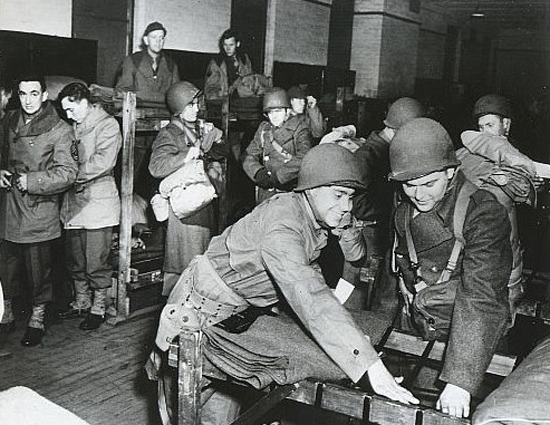
1943-1944, US troops and replacements arriving in the United Kingdom.
England:
The Hospital landed at Liverpool, England, 8 January 1944. After assembly, the organization entrained for Castle Cary, Somerset, England, where it arrived 11 January. The Enlisted personnel were temporarily billeted in several buildings, with Headquarters, Nurses Quarters, Mess Section, Motor Section, and Unit Supply Section installed in “Florida House”. The remainder men were moved to barracks in “Squibbs Meadow”. Officers were billeted in private homes. The Medical Service, X-Ray, Pharmacy, Laboratory, and Medical Supply Sections were located in different buildings in town. Converted bowling alleys served the Medical Section and the Operating Section. A large hall known as “Constitution Hall” was used as the EM’s Mess Hall, and for recreation of the Enlisted personnel.
On 15 June 1944, the 97th departed Castle Cary, England, by rail arriving at the marshalling area, Camp Piddlehinton, Dorset, England, the same date (during the D-Day build up, the US Army operated an airstrip in the area for L-4s belonging to the 62d Armored Field Artillery Battalion –ed). A motor convoy of 29 vehicles and 20 1-ton cargo trailers, loaded with unit equipment followed and arrived at the prescribed marshalling area 15 June. During their stay at the marshalling area, necessary waterproofing of all vehicles was completed, troops were briefed, money was exchanged for proper type “invasion” currency, a partial payment of $4.00 per man was effected, and PX rations were drawn by all personnel.
The unit departed Camp Piddlehinton, Dorset, England, 16 June, moving by motor convoy (mainly consisting of 6×6 2 ½-ton cargo trucks) with destination the embarkation area at Weymouth, England. Upon arrival, the group was assembled, received its last instructions, and boarded 2 LCIs (Landing Craft Infantry –ed). The unit’s vehicles and trailers, which had left by separate convoy, were loaded onto an LST (Landing Ship Tank –ed) for the Channel crossing the same day. Although the voyage proved “scary” there were no incidents. Seasickness remained low and no specific difficulties were encountered during the crossing and the subsequent landing on the French coast. No vehicles or equipment was lost or damaged during the trip. Unit vehicles and the accompanying personnel rejoined the 97th Evac Hosp 12 hours later on the continent.
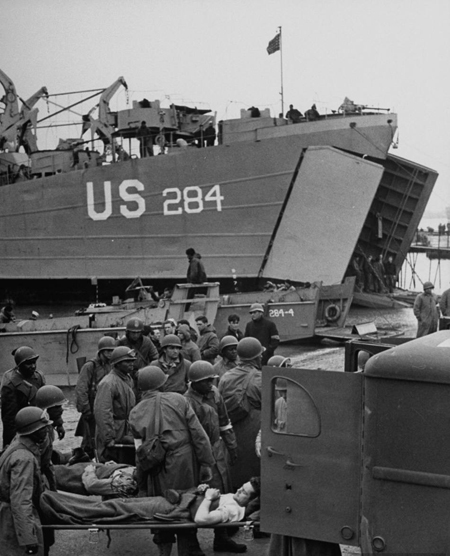
Southern England 7-8 June 1944. D-Day casualties are brought ashore for evacuation to transit and other Hospitals for further medical treatment.
France:
Shortly after arrival in Normandy, France (Utah Beach), contact was made with VII Corps Headquarters and it was decided to temporarily quarter the unit with the 45th Field Hospital near Sainte-Mère-Eglise. Four days later the 97th was assigned an area for establishment of the Hospital 3 miles northwest of St-Sauveur-le-Vicomte, where it officially opened on 21 June 1944. By 2400 hrs 21 patients had been admitted of which 17 were battle casualties and 4 non-battle casualties; 3 prisoners of war and 3 civilians were included as well. During this initial phase of operations, the drive for Cherbourg was in progress and the position was accepting casualties from the east flank of the operation. The site of the Hospital at that time was approximately 20 miles northwest of the nearest Evacuation Hospital and about 16 miles south of Cherbourg. The heaviest rate of casualties was registered in the period ranging from 22 to 26 June inclusive. 515 cases were received between 1800 hrs (22 June) and 1200 hrs (23 June); in barely a period of 18 hours. Auxiliary Surgical Teams were attached to the unit from 21 to 25 June, including additional EM detached from other units in the neighborhood.
On 24 June 1944, 17 Officers, 20 Nurses, and 82 Enlisted Men from the 34th Evacuation Hospital were attached and the remaining cases in the Hospital were rapidly prepared for evacuation. During the period 21 June to 6 July 1944, inclusive, the summary of patients treated at the 97th Evac was as follows:
| Admissions 878 patients | Returned To Duty 55 patients |
| Evacuated & Transferred 810 patients | Deaths 13 patients |
Troops who had participated in the Cherbourg drive and assault were brought back into rest areas near the Hospital. The bath (shower) unit at that time was taxed to the limit by these troops, and at one time the shower unit provided showers for about 1500 men in one day. This location was 4 1/2 miles north of La Haye-du-Puits, which roughly represented the current frontline to the south. In the artillery bombardment for the drive south on La Haye-du-Puits and Lessay (a little further south of the above town), the 97th was surrounded by many field artillery units. The bombardment of La Haye-du-Puits which took place between 3 and 4 July 1944, seemed like a good celebration of the “Fourth of July” on a grand scale to the Hospital personnel.

97th Evacuation Hospital personnel setting up in Normandy early July 1944.
Between 8 – 23 July 1944, the organization was in operation 2 miles southwest of St-Sauveur-le-Vicomte, having moved to its new location on 7 July. The unit was once more situated on the east flank, very near the frontline, and approximately 3 miles ahead of the Medical Clearing Company from which it received patients. There was no Field Hospital ahead of them and they were consequently receiving non-transportable patients who ordinarily would have been accepted by Field Hospital units. Here also an informal transfer of patients that were transportable was put into practice. Problems in this area again involved shortage of personnel, and for the first and only time the whole blood supply, necessary for transfusions, was inadequate. A Blood Bank for fresh blood was immediately formed; with about 15 pints per day secured which supplemented the supply of stored blood to adequacy. The high death rate was a result of the large number of non-transportable cases received.
During this period of activity the Hospital developed the most satisfactory system for the employment of the necessary attached EM, including Litter Bearers and Medical and Surgical Technicians.
Before the Hospital opened for patients (early July 1944), the entire 463d Medical Collecting Company, minus the Ambulance Platoon, was attached for duty. The unit also used 20 German PWs for extra labor and other work details.
| Admissions 1405 patients | Informal Transfers 707 patients |
| Evacuated & Transferred 616 patients | Returned To Duty 32 patients |
| Deaths 50 patients |
From 25 to 30 July 1944, the 97th Evac was in the “Rest Area”, 1 mile north of Lison. During this period the electrical system was completely overhauled and a new 3-phase generator installed by Army Engineers.
In the period 31 July – 12 August 1944, the Hospital was operating 1/2 mile northeast of Les Bruyères. In this location the organization had an abundance of professional help prior to receiving any patients. A total of 52 MC and ANC Officers in organized “teams” were attached from the 1st Auxiliary Surgical Group, the 3d Auxiliary Surgical Group, and from 2 General Hospitals which were not operating at that time. With this amount of help, the unit’s equipment was put to a test as to its capabilities. The maximum number of patients received in a 12-hour period was 392, all of which were given definitive treatment and readied for evacuation within 36 hours. There was no undue strain on the equipment; however at this time a mobile surgical unit was secured for extra help. This unit was effectively used for doing definitive treatment on minor cases. Performance was high, with one surgical team being able to complete 50 to 60 such cases in 12 hours only using that unit. The unit was ideal for either major or minor cases and proved a valuable addition to the Hospital staff and personnel, including the additional equipment it brought along which was a real asset. The summary of patients for the above period is as follows:
| Admissions 1165 patients | Informal Transfers 36 patients |
| Evacuated & Transferred 1063 patients | Returned To Duty 52 patients |
| Deaths 14 patients |
From 13 to 20 August 1944, the 97th Evac Hosp was operating 1 mile northeast of Coulouvray-Boisbenâtre. The period of activity was only brief with a low census of patients treated. The summary of patients included:
| Admissions 216 patients | Informal Transfers 17 patients |
| Evacuated & Transferred 191 patients | Returned To Duty 4 patients |
| Deaths 4 patients |
Between 21 August and 4 September 1944 the period was spent in the “Rest Area”, 1 mile east of Remalard. During this time 2 large double ward tents were constructed and some general refitting accomplished. 3 Medical Administrative Officers were transferred to other field units. 1 Master Sergeant, 1 First Sergeant, and 1 Chief Warrant Officer were appointed 2d Lieutenants MAC, and 1 Technical Sergeant was promoted to Warrant Officer, Junior Grade. All were battlefield promotions. The civilians of this community were very cordial towards the unit. Many invitations for visiting private homes were received; the majority of which were gladly accepted. Every effort was made by the French civilian population to show their appreciation and respect for their presence.

Partial view illustrating one of the operating rooms at the 97th Evacuation Hospital. Picture taken mid-August 1944 in the area of Couvray-Boisbenâtre, France.
From 4 to 6 September 1944, the organization was active and located 1/2 mile northwest of La Capelle (toward the Franco-Belgian border). This move of 210 miles was accomplished during 3 and 4 September, with the Hospital opening for patients only ten hours after arrival. Here, the greatest volume of patients to date were received. Little surgical work was performed and the majority of the job consisted in preparing and transferring patients from the Army Area to the Communications Zone Area (ComZ). Each patient had to be formally admitted and discharged. Those that were non-transportable were retained at the unit’s location. The highest census achieved in a 24-hour period was 579. The greatest number disposed of in a 24–hour period was 518. Additional help from Officers and Enlisted personnel was requested and secured from nearby inactive Hospitals. Here the administrative sections were put to some test and the number of cases admitted and discharged did not overtax the department thanks to their augmented personnel. The largest number of patients at any one time was 850. The summary for the period was as follows:
| Admissions 2623 patients | Informal Transfers 10 patients |
| Evacuated & Transferred 2555 patients | Returned To Duty 17 patients |
| Deaths 41 patients |
Belgium:
During the period 16 to 26 September 1944, the 97th was located 1 mile north of Eupen, in the eastern part of Belgium. The move was accomplished during 16 and 17 September. The initial intention was to go to a rest area. However, on 19 September the CO was notified to be ready to receive patients at 1800 hours. Now acting as a Holding (or transfer) unit, 22 ward tents were immediately pitched and the necessary equipment installed in that period of time, so that patients were already received at 2000 that evening. The ward section again showed great flexibility as about 100 battle exhaustion cases were received, and sedative treatment began. Treatment and evaluation of these cases caused a special problem. Consultation took place with the 134th Medical Group, who had previously treated all such cases and their experience was greatly appreciated, as it was needed for the correct handling of such cases. In this location the physical set up and daily maintenance of the Hospital area became a difficult problem due to excessive rain and mud conditions caused by severe adverse weather conditions. The summary of patients for that particular period was:
| Admissions 727 patients | Informal Transfers 8 patients |
| Evacuated & Transferred 707 patients | Returned To Duty 11 patients |
| Deaths 1 patient |
Between 26 September and 23 November 1944, the Hospital equipment was stored and a guard detachment remained behind with it at Eupen, Belgium. Personnel however were now moved to Dolhain, Belgium, and upon arrival were quartered in four different buildings. The main portion of the personnel was housed in the “Ecole Moyenne de l’Etat” (State school), at the Rue Guillaume Maissier. Others were sent to the “Ecole Moyenne Gymnasium” (another school). Nurse quarters were situated at the “Maison Departer”, Rue Wilson. The unit’s band provided a great source of entertainment and diversion during this particular period. The orchestra played for the evening meal 4 to 5 times per week. Entertainment by the Hospital band and various groups provided for the necessary entertainment. The Nurses organized dances and visits. The new type of ‘Ike’ 1944-type woolen field jackets were issued, and replacement of unserviceable clothing was accomplished.
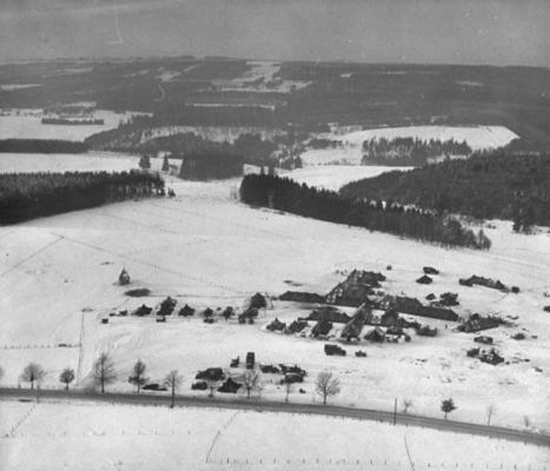
Aerial view of a US Evacuation or Field Hospital in the Belgian Ardennes. Picture taken during winter 1944-1945.
Germany – Belgium:
Between 24 November and 20 December 1944, the unit operated a 1/4 mile northeast of Brand (Aachen), Germany. This was the FIRST operation of the unit in fixed buildings, previously all installations had been under tentage. The occupied buildings had been a German Military Institution consisting of 3 large buildings. After arrival, the different departments were grouped and spread over the available buildings. Receiving, Disposition and Evacuation, Pre-Operative and Shock, X-Ray, Pharmacy, and Laboratory, including 2 Post-operative wards were installed in one building; the Ward Section in another building; and the Administrative Section and Personnel set up in the remaining building. The buildings were well constructed and had adequate sanitary and heating facilities. The only problem was the absence of elevators for movement of patients and as the buildings were 3 stories high the amount of work required to carry litter patients to their respective wards proved a serious disadvantage. However, the buildings were sufficiently large to house all attached personnel.
In the period, strafing of the Hospital area by enemy aircraft occurred frequently but no casualties were ever reported. Many American anti-aircraft batteries were located near the area (a calculated risk). The summary of patients for the period was as follows:
| Admissions 3779 patients | Informal Transfers 34 patients |
| Evacuated & Transferred 3660 patients | Returned To Duty 38 patients |
| Deaths 47 patients |
During the period 21 to 23 December 1944, the 97th Evac Hosp was inactive or almost constantly on the move due to the German breakthrough in the Belgian Ardennes. Some medical units were retreating, others were transferred to the rear, and some moved to other sites, while trying to stay ahead and clear of the enemy forces.
Between 24 December and 5 January 1945, the organization was back in operation. On 1 January 1945, New Year’s Day, it set up in some civilian buildings at Verviers, Belgium, together with the 128th Evacuation Hospital. The unit was located in one large building; half of the personnel was housed in another building; and Headquarters in a portion of yet another building. Heating by stoves was absolutely required as no hot tap water was available. A shower unit was installed in one of the washrooms with the disinfector just outside the room and hot water was run into the showers by a rubber hose. During this trying winter period 12 members of the unit were awarded the Bronze Star Medal for meritorious service performed between June and October 1944. The Hospital received due credit for its participation in the Normandy campaign.
The average number of patients handled per day was 234 for 21 consecutive days. During the period, the organization was directly supporting First US Army troops fighting in the Ardennes (Battle of the Bulge). The summary of patients for the period was:
| Admissions 4401 patients | Informal Transfers 33 patients |
| Evacuated & Transferred 4628 patients | Returned To Duty 51 patients |
| Deaths 49 patients |
From 26 January to 17 March 1945, the buildings occupied by the unit in Malmédy, Belgium, were very dirty and in an extremely poor condition. Fortunately, only slight bomb damage had been incurred by the buildings during the “Battle of the Bulge”. However, the bomb damage affected the water supply which could not be resumed for more than three weeks. Heavy snow fall and the 18″ deep frost line made outside construction nearly impossible without help of Army Engineers equipment. The area grounds were a veritable mass of litter, junk, and filth after having been vacated by an “Army Division” ration breakdown point. After some serious cleanup, repairs, and reorganization, the Hospital opened for patients on 30 January 1945, supporting troops engaged in a holding action in that area after restabilization of the battle lines as a result of the enemy counter-offensive which started 16 December 1944. The summary of patients was as follows:
| Admissions 2418 patients | Informal Transfers 17 patients |
| Evacuated & Transferred 2282 patients | Returned To Duty 82 patients |
| Deaths 37 patients |
Germany:
Between 18 March and 7 April 1945, the organization was established in Ahrweiler, Germany. The 97th was housed in buildings pertaining to a Catholic School and Convent, and had previously served as a German Lazarett prior to occupation by the new tenants. Upon the arrival of the Hospital unit, there was still 1 German Medical Officer, 6 German Medical Enlisted Men, and 14 patients in the buildings. Generally speaking, the buildings were in good condition. Many of the window panes were broken, however most of them were repaired within a few days. Sanitary facilities were in good working condition, as well as the cold and hot water and the heating systems. Necessity for hiring extra labor to supplement assigned personnel was obviated by the fact that the Nuns of the Convent volunteered their services for practically all of the cleaning and general housekeeping responsibilities. The Hospital was primarily supporting the troops engaged in the fighting in and after the breakout from the Remagen bridgehead. On 7 April one unit of the 47th Field Hospital moved in and took over the 14 remaining non-transportable patients in the Hospital. Summary of patients:
| Admissions 2226 patients | Informal Transfers 0 patients |
| Evacuated & Transferred 2098 patients | Returned To Duty 97 patients |
| Deaths 31 patients |
Period 8 to 12 April 1945: on 8 April the 97th started moving personnel & equipment to Kassel, Germany by air. The unit was scheduled to receive 60 aircraft for subject movement. However, due to long range enemy artillery fire on a nearby airfield, from which another Hospital was scheduled to move, it was necessary to change priorities and divert half the planes to that other unit, the result being that 3 days were required for implementing the move. After arrival in Kassel and while awaiting orders to operate again, the Officers and Nurses bivouacked in Bad Wildungen, leaving the EM at the airfield to watch over the equipment.
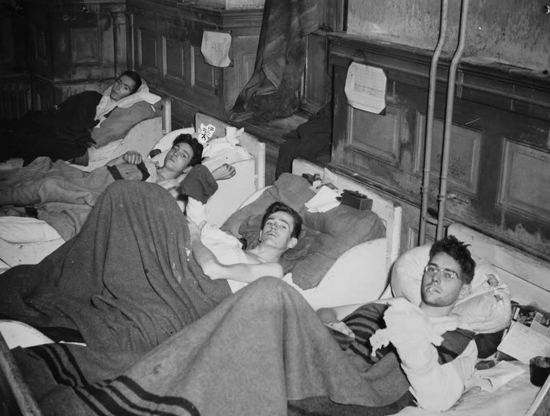
Germany, March 1945. Patients set up inside a requisitioned building are waiting for further treatment by medical personnel…
Between 13 and 29 April 1945, the organization was established at Duderstadt, Germany. The entire unit moved by truck to the vicinity of Duderstadt where it functioned in support of the operations in the Harz Mountain area. The operation was under canvas for the first time since September 1944. Despite some of the difficulties and inconveniences, caused by the cold rainy weather with resulting mud, function under tentage again was quite satisfactory. The summary of patients was as follows:
| Admissions 1220 patients | Returned To Duty 19 patients |
| Evacuated & Transferred 1187 patients | Deaths 14 patients |
From 30 April to 23 June 1945, the 97th was located near Weimar, Germany. The unit went into bivouac in buildings of a former German Luftwaffe airbase and Signal School in the vicinity of Weimar, where it became responsible for PWs, DPs, and operated a feeding point for transient RAMPs at the airstrip. This lasted from 5 to 8 May 1945. The celebration of VE-Day was thoroughly enjoyed by the entire unit. Many of the Officers and Enlisted Men were immediately placed on DS supervising and completely administering captured German Military Hospitals. Several Nurses were placed on temporary duty with the 4th Convalescent Hospital and the 13th Field Hospital. The balance of personnel was meanwhile engaged in military training, athletics, and recreational activities as well as Phase I of the post-hostilities Information & Education program. Following application of the RR-1 program, the organization was placed in Category IV, however it was not materially affected other than by the administrative requirements necessary in connection with the Points (ASR scores –ed) credit system applicable to each individual of the command. Some changes were made in assignment of personnel and as a result of the Redeployment program as follows: 1 Officer was transferred out of the unit; 5 EM were transferred from the unit (over 40 yrs old); 5 EM were transferred to another unit (some had over 85 points); 11 EM were transferred to “alerted” units (under 85 points); finally 8 EM joined from other units (over 85 points).
Between 24 June and 11 July 1945, the Hospital’s new site was Alzey, Germany. The unit relieved the 133d Evacuation Hospital that was servicing one Infantry Regiment of the 28th Infantry Division. The site had been formerly occupied by a civilian mental institution and consisted of 5 buildings. Three of these were used for hospitalization and administration with the remainder serving as billets. The area also provided swimming pool and tennis courts which were used to the fullest extent in the rehabilitation program conducted for the convalescent patients. Initial readjustment of personnel under RR 1-1 was completed during this period by an interchange of people with the 91st Evacuation Hospital. The unit closed operations 10 July 1945. The territory serviced was now within the zone to be occupied by the French Army. The summary of patients was:
| Admissions 266 patients | Returned To Duty 212 patients |
| Evacuated & Transferred 212 patients | Deaths 5 patients |
Period 12 July to 19 September 1945, the 97th was established in Stuttgart, Germany, where it opened to service elements pertaining to the 100th Infantry Division. The building which had not suffered any war damage was a former civilian Homeopathic Hospital endowed by Robert Bosch, the industrialist, and proved to be most modern in every detail. An arrangement was made so that part of the building remained under jurisdiction of the German medical staff for the treatment of civilian patients. This agreement in no way interfered with the efficiency of the operation of the American Hospital unit. The Enlisted personnel were billeted in a nearby civilian apartment building while the Officers were quartered in buildings on the Hospital grounds. A 60-days patient evacuation policy was in effect during this operation.
During the same period Colonel William S. George, MC, the organization’s Commanding Officer throughout the entire combat operations was relieved from duty and Colonel Duane F. Hartshorn assumed command. Operation of the 97th Evac was then transferred to the 51st Evacuation Hospital to facilitate another readjustment of personnel prior to its departure from official Army control. Summary of patients:
| Admissions 972 patients | Returned To Duty 212 patients |
| Evacuated & Transferred 757 patients | Deaths 3 patients |
The End:
After closing of the 97th Evacuation Hospital in Stuttgart only a unit Headquarters was maintained to coordinate transfer of personnel. All the Enlisted Men with Adjusted Service Rating (ASR –ed) scores of 85 or more (Points –ed) were transferred to the 106th Infantry Division; this involved all but three men! On 12 September, 242 EM from the 36th Infantry Division with “VE” ASR scores ranging between 70 and 74 points were assigned to the Hospital. 17 September, all Medical Corps Officers were transferred to the 19th Reinforcement Depot, in order to be flown to the Zone of Interior under the “Green Project”.
On 18 September 1945, Colonel D. F. Hartshorn was relieved of command and assigned to the 51st Evacuation Hospital. Major James E. Emmons was appointed as the new CO.
From 20 September to 2 November 1945, the unit staged at Camp San Antonio, France (one of the City camps). The 97th was alerted and moved to the Assembly Area Command (near Marseille –ed) by motor convoy on 19 September, as per Letter, Headquarters, Seventh United States Army, Western Military District, AG 370.5-0-484 dated 8 September 1945; Subject: Movement Orders-Redeployment.
After arrival at Camp “San Antonio”, France (one of the “City” Camps –ed), 20 September, final readjustment of personnel was accomplished and the unit was ordered to Calas, Southern France, Staging Area, to await shipment to the Zone of Interior for proper deactivation.
Period 3 to 21 November 1945, Calas, France: the 97th Evac Hosp departed France aboard the “Walter Ranger” (Liberty Ship). The vessel reached Cp. Myles Standish (Staging Area) 22 November. Continental United States: Zone of Interior, Thanksgiving Dinner was enjoyed at Cp. Myles Standish, Boston, Massachusetts.
The 97th Evacuation Hospital was officially inactivated 23 November 1945 with all personnel dispatched to the various Separation Centers in the States for Honorable Discharge from military service.
97th Evacuation Hospital (SM) Campaign Credits, World War 2
“NORMANDY”
“NORTHERN FRANCE”
“RHINELAND”
“ARDENNES-ALSACE”
“CENTRAL EUROPE”
The unit served with First United States Army”, “Third United States Army”, and “Seventh United States Army” during its stay in the European Theater of Operations.
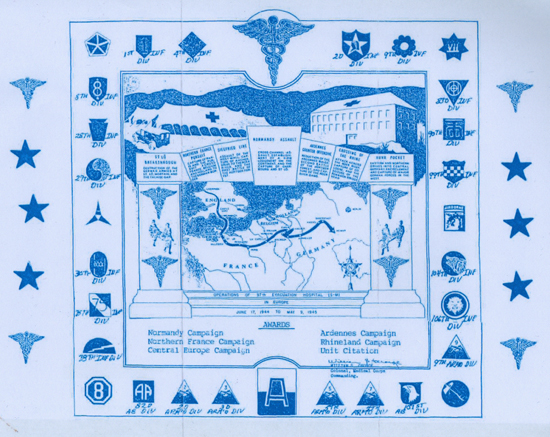
Illustration showing the Operations of the 97th Evacuation Hospital in Europe, June 17, 1944 to May 9, 1945. This postwar map illustrates the official campaign awards, and units serviced by the unit during its stay in the ETO. Someone has added a written identification under the Division shoulder patches and it must also be noted that the First United States Army SSI is the postwar version (this map could be a cover or an illustration of a booklet published and distributed to the members of the 97th Evac Hosp after WW2).
We are truly indebted to Jean Eichhorn who provided us with the above excerpts of official documents compiled and edited by Charles Kent and venerably treasured by Jean’s Uncle Technician 5th Grade George C. Swanton (ASN:31176964). Without her generous help we would not have been in a position to prepare this Unit History. Thank you, the MRC Staff.
